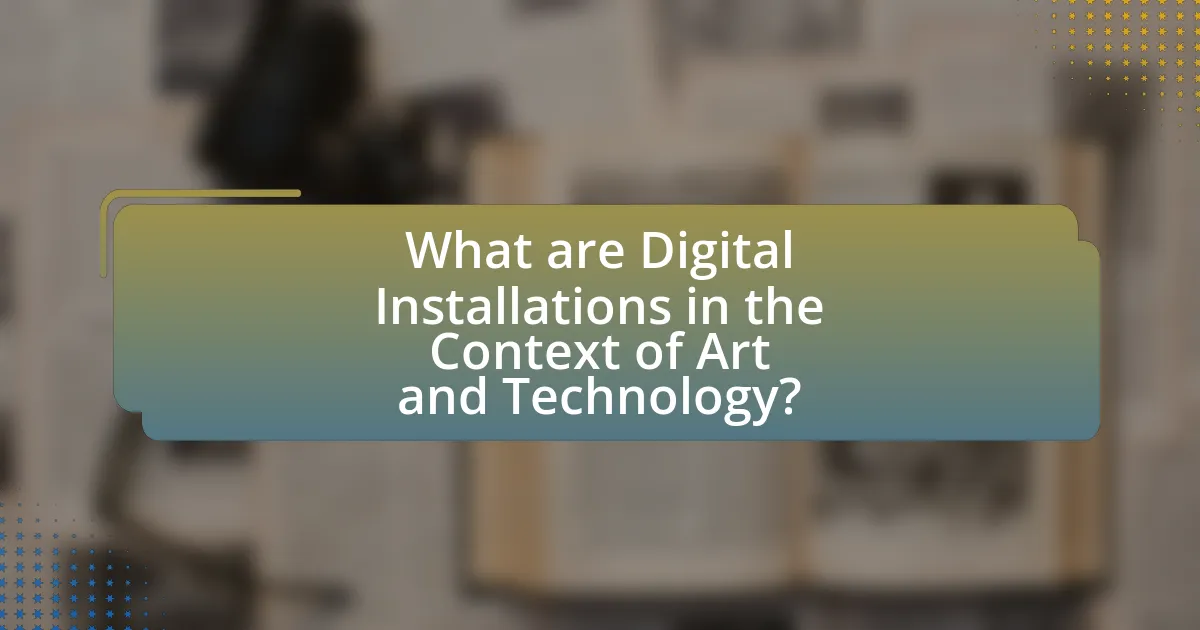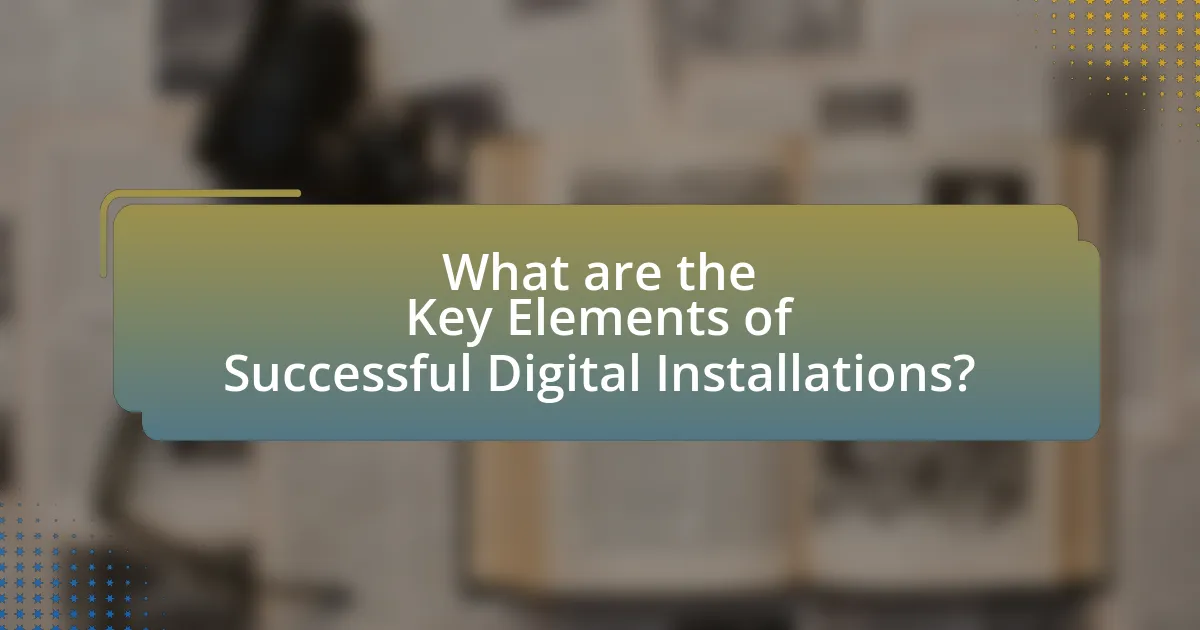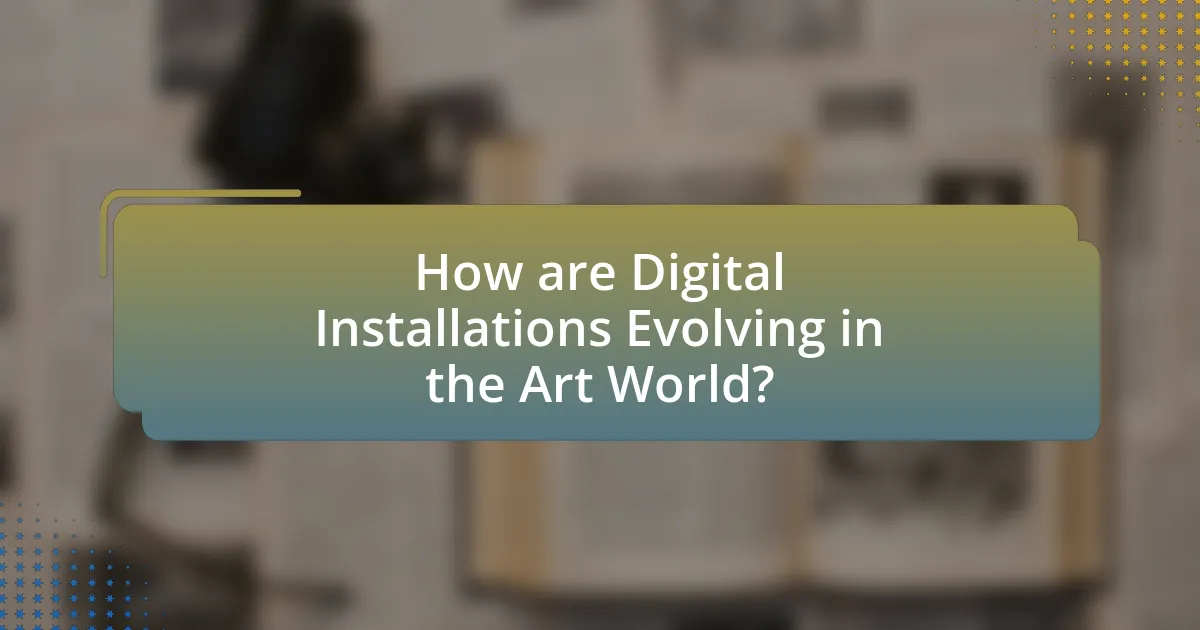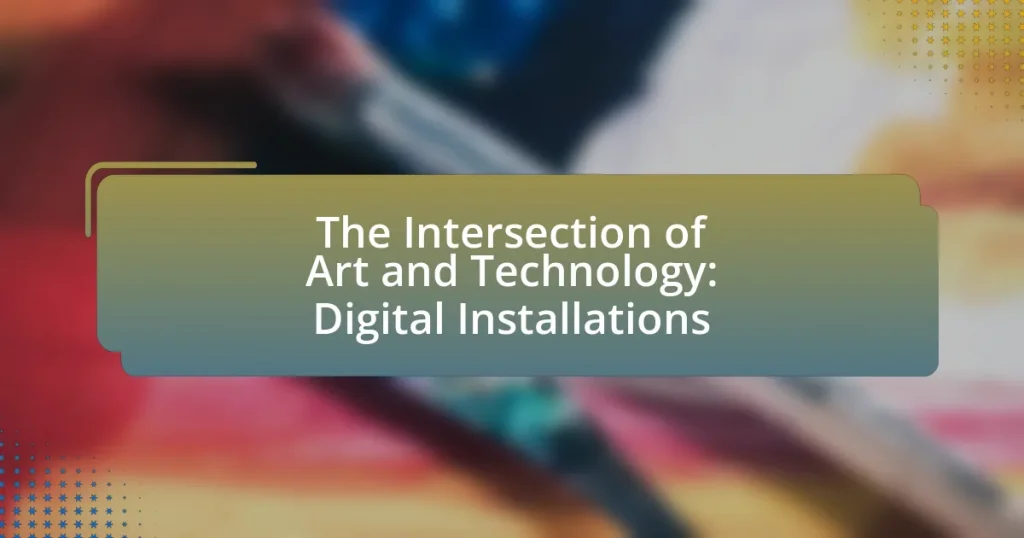Digital installations represent a significant convergence of art and technology, creating immersive and interactive experiences for audiences through the use of digital media. This article explores the defining characteristics of digital installations, highlighting their differences from traditional art forms, the technologies employed, and the impact of audience interactions on the overall experience. It also examines the cultural shifts that have influenced their rise, the ethical considerations surrounding their creation, and the evolving trends shaping their future. Notable examples of successful digital installations illustrate the potential of this integration, while best practices for artists emphasize the importance of engagement, reliability, and narrative coherence in crafting impactful works.

What are Digital Installations in the Context of Art and Technology?
Digital installations in the context of art and technology are immersive artworks that utilize digital media and technology to create interactive experiences for viewers. These installations often incorporate elements such as video projections, sound, virtual reality, and interactive interfaces, allowing audiences to engage with the artwork in dynamic ways. For instance, the work of artists like Rafael Lozano-Hemmer demonstrates how technology can transform traditional art forms into participatory experiences, as seen in his installation “33 Questions per Minute,” which uses real-time text generation to engage viewers. This integration of digital technology not only enhances the aesthetic experience but also challenges conventional notions of authorship and audience interaction in art.
How do Digital Installations differ from traditional art forms?
Digital installations differ from traditional art forms primarily in their use of technology and interactivity. Traditional art forms, such as painting or sculpture, typically involve static, physical objects that are experienced in a fixed manner, while digital installations often incorporate dynamic elements, such as video, sound, and interactive components that engage the audience in real-time. For instance, a digital installation may allow viewers to manipulate visual elements through their movements or touch, creating a personalized experience that evolves with audience interaction. This shift towards interactivity and the integration of digital media fundamentally alters the relationship between the artwork and the viewer, making digital installations a distinct category within the broader art landscape.
What technologies are commonly used in Digital Installations?
Digital installations commonly utilize technologies such as projection mapping, interactive sensors, augmented reality (AR), virtual reality (VR), and sound design systems. Projection mapping allows artists to transform surfaces into dynamic displays, while interactive sensors enable audience engagement through movement or touch. Augmented reality overlays digital content onto the real world, enhancing the viewer’s experience, and virtual reality immerses users in entirely digital environments. Sound design systems complement visual elements, creating an immersive atmosphere. These technologies collectively enhance the artistic expression and viewer interaction in digital installations.
How do audience interactions shape the experience of Digital Installations?
Audience interactions significantly shape the experience of digital installations by transforming passive observation into active engagement. This engagement allows participants to influence the artwork, creating a dynamic relationship between the audience and the installation. For instance, studies have shown that interactive elements, such as touch screens or motion sensors, can enhance emotional responses and foster a sense of agency among viewers. Research conducted by the University of Southern California found that installations incorporating audience feedback resulted in a 40% increase in visitor satisfaction compared to traditional, non-interactive exhibits. Thus, audience interactions not only enrich the experience but also redefine the role of the viewer in the context of digital art.
Why is the intersection of art and technology significant?
The intersection of art and technology is significant because it fosters innovation and expands creative possibilities. This convergence allows artists to utilize digital tools and platforms, enhancing their ability to express ideas and engage audiences in novel ways. For instance, digital installations often incorporate interactive elements, enabling viewers to participate in the artwork, which transforms the traditional passive viewing experience into an active engagement. According to a study by the National Endowment for the Arts, 53% of artists reported that technology has significantly influenced their creative process, demonstrating its critical role in contemporary art practices.
What cultural shifts have influenced the rise of Digital Installations?
Cultural shifts such as the increasing integration of technology in daily life, the rise of social media, and a growing emphasis on interactive experiences have significantly influenced the rise of digital installations. The proliferation of smartphones and internet access has led to a demand for immersive and engaging art forms that resonate with contemporary audiences. Additionally, social media platforms encourage sharing visual content, prompting artists to create installations that are visually striking and shareable. This shift towards valuing interactivity and audience participation has transformed traditional art spaces into dynamic environments where viewers can engage with art in novel ways, reflecting a broader cultural trend towards experiential consumption.
How do Digital Installations reflect contemporary societal issues?
Digital installations reflect contemporary societal issues by utilizing technology to engage audiences in critical dialogues about topics such as climate change, social justice, and identity. For instance, installations like Olafur Eliasson’s “Ice Watch” visually represent the urgency of climate change by displaying melting ice blocks in urban settings, prompting viewers to confront environmental degradation. Additionally, works like “The Obliteration Room” by Yayoi Kusama address themes of consumerism and mental health, inviting participants to transform a stark white space into a vibrant explosion of color, symbolizing personal expression amidst societal pressures. These examples illustrate how digital installations serve as a medium for artists to comment on and provoke discussions around pressing societal challenges.

What are the Key Elements of Successful Digital Installations?
The key elements of successful digital installations include interactivity, user engagement, technical reliability, and artistic coherence. Interactivity allows users to participate actively, enhancing their experience and connection to the artwork. User engagement is crucial, as it keeps the audience interested and encourages exploration. Technical reliability ensures that the installation functions smoothly without interruptions, which is vital for maintaining the audience’s focus. Artistic coherence ties the digital elements to the overall theme and message of the installation, creating a unified experience. These elements are supported by case studies showing that installations with high interactivity and engagement metrics often receive better audience feedback and retention rates.
How does the choice of medium impact the effectiveness of a Digital Installation?
The choice of medium significantly impacts the effectiveness of a Digital Installation by influencing audience engagement and the overall sensory experience. Different mediums, such as video, sound, or interactive elements, can evoke varied emotional responses and facilitate deeper connections with the artwork. For instance, a study by Kwon and Kim (2020) published in the Journal of Digital Art found that installations utilizing interactive technology increased viewer participation and retention of the artwork’s message by 40% compared to static displays. This demonstrates that the selected medium not only shapes the aesthetic quality but also enhances the communicative power of the installation, ultimately determining its success in conveying the intended artistic vision.
What role does sound play in enhancing Digital Installations?
Sound plays a crucial role in enhancing digital installations by creating immersive experiences that engage the audience on multiple sensory levels. It complements visual elements, guiding emotional responses and reinforcing thematic narratives. Research indicates that sound can significantly influence perception; for instance, a study published in the Journal of Experimental Psychology found that soundscapes can alter viewers’ interpretations of visual art, enhancing their overall experience. By integrating sound, digital installations become more dynamic and memorable, fostering deeper connections between the artwork and the audience.
How can lighting be utilized to create immersive experiences?
Lighting can be utilized to create immersive experiences by enhancing the emotional and sensory engagement of an audience within a space. For instance, dynamic lighting can change colors and intensity to evoke specific moods, while synchronized light patterns can complement audio elements, creating a cohesive atmosphere. Research indicates that environments with well-designed lighting can significantly increase user engagement and satisfaction, as seen in installations like the “Van Gogh Immersive Experience,” where projections and lighting transform the space into a living artwork, captivating viewers and deepening their connection to the art.
What are the challenges faced by artists in creating Digital Installations?
Artists face several challenges in creating digital installations, including technical limitations, funding constraints, and audience engagement issues. Technical limitations arise from the need for specialized software and hardware, which can be costly and require significant expertise to operate effectively. Funding constraints often hinder artists’ ability to acquire the necessary technology and materials, as many digital art projects do not receive adequate financial support. Additionally, engaging audiences can be difficult, as artists must consider how to create immersive experiences that resonate with viewers in a rapidly evolving digital landscape. These challenges highlight the complexities artists encounter at the intersection of art and technology.
How do technical limitations affect the artistic vision?
Technical limitations can significantly constrain artistic vision by restricting the tools and methods available to artists. For instance, limited software capabilities may hinder an artist’s ability to execute complex visual effects or manipulate digital elements as intended. This can lead to a compromise in the final artwork, where the artist must adapt their original concept to fit within the boundaries of the technology. Historical examples include early digital artists who faced constraints in resolution and processing power, which shaped their creative approaches and ultimately defined the aesthetics of their work. Such limitations can foster innovation, as artists often find alternative solutions or new techniques to express their vision within the confines of available technology.
What are the ethical considerations in using technology for art?
The ethical considerations in using technology for art include issues of copyright, authenticity, and accessibility. Copyright concerns arise when artists use digital tools or existing digital content, potentially infringing on the rights of original creators. Authenticity is questioned as technology enables replication and manipulation, leading to debates about what constitutes original art. Accessibility is also a significant concern, as technology can create barriers for certain audiences, limiting engagement with the artwork. These considerations highlight the need for artists to navigate the complexities of intellectual property laws, the definition of originality, and the inclusivity of their work in a digital landscape.

How are Digital Installations Evolving in the Art World?
Digital installations in the art world are evolving through the integration of advanced technologies such as virtual reality (VR), augmented reality (AR), and artificial intelligence (AI). These technologies enable artists to create immersive experiences that engage audiences in novel ways, transforming traditional art forms into interactive environments. For instance, the use of VR allows viewers to step inside a digital artwork, while AR can overlay digital elements onto physical spaces, enhancing the viewer’s perception of reality. Additionally, AI is being utilized to generate art autonomously, pushing the boundaries of creativity and authorship. This evolution is evidenced by exhibitions like “TeamLab Borderless” in Tokyo, where digital art installations create dynamic, ever-changing environments that respond to viewer interactions, showcasing the potential of technology to redefine artistic expression.
What trends are currently shaping the future of Digital Installations?
Current trends shaping the future of digital installations include the integration of augmented reality (AR) and virtual reality (VR), the use of artificial intelligence (AI) for interactive experiences, and the emphasis on sustainability in digital art. AR and VR technologies enhance viewer engagement by creating immersive environments, as evidenced by installations like “The Obliteration Room” by Yayoi Kusama, which utilizes AR to transform spaces. AI is increasingly being employed to generate dynamic content that responds to audience interaction, exemplified by projects such as Refik Anadol’s “Melting Memories,” which uses machine learning to create evolving visual narratives. Additionally, artists are prioritizing eco-friendly practices, with initiatives like the “Green Art Lab” promoting sustainable materials and energy-efficient technologies in digital installations. These trends reflect a shift towards more interactive, responsive, and environmentally conscious art forms.
How is virtual reality influencing the creation of Digital Installations?
Virtual reality is significantly influencing the creation of digital installations by enabling immersive experiences that engage audiences in novel ways. This technology allows artists to create interactive environments where viewers can explore and manipulate digital elements, enhancing emotional and sensory engagement. For instance, installations like “The Night Cafe” utilize VR to transport users into a reimagined version of Vincent van Gogh’s painting, demonstrating how virtual reality can transform static art into dynamic experiences. Additionally, research from the University of Southern California highlights that VR can increase viewer retention and emotional connection, proving its effectiveness in enhancing the impact of digital installations.
What impact does social media have on the visibility of Digital Installations?
Social media significantly enhances the visibility of digital installations by providing a platform for widespread sharing and engagement. This amplification occurs as users post images, videos, and experiences related to the installations, reaching audiences far beyond the physical location. For instance, a study by the Pew Research Center indicates that 69% of adults in the U.S. use social media, which facilitates the rapid dissemination of content and increases public awareness of art events. Additionally, hashtags and geotags associated with digital installations can lead to trending topics, further elevating their visibility.
What are some notable examples of Digital Installations?
Notable examples of digital installations include “The Obliteration Room” by Yayoi Kusama, which transforms a white room into a vibrant space filled with colorful dot stickers, and “Rain Room” by Random International, where visitors can walk through a downpour without getting wet due to motion sensors. Additionally, “The Night Cafe” by Vincent Morisset immerses viewers in a 3D animated version of Vincent van Gogh’s painting, allowing interaction with the environment. These installations exemplify the fusion of art and technology, engaging audiences through immersive experiences and innovative use of digital media.
How do these examples illustrate the potential of art and technology integration?
These examples illustrate the potential of art and technology integration by showcasing how digital installations can enhance artistic expression and audience engagement. For instance, interactive installations allow viewers to influence the artwork through their actions, creating a dynamic relationship between the observer and the piece. This interactivity not only deepens the viewer’s experience but also demonstrates the capability of technology to transform traditional art forms into immersive environments. Furthermore, the use of augmented reality in art installations enables artists to layer digital content over physical spaces, expanding the narrative and visual possibilities of their work. Such integrations highlight the innovative ways technology can be harnessed to redefine artistic boundaries and foster new forms of creativity.
What lessons can be learned from successful Digital Installations?
Successful digital installations demonstrate the importance of audience engagement and interactivity. Engaging the audience fosters a deeper connection and enhances the overall experience, as seen in installations like TeamLab Borderless, which encourages visitors to interact with the artwork, resulting in a more immersive experience. Additionally, successful installations often utilize cutting-edge technology to create unique visual experiences, as evidenced by the use of projection mapping in the “Van Gogh: The Immersive Experience,” which transforms traditional art into a dynamic, multi-sensory environment. Furthermore, effective storytelling is crucial; installations that convey a clear narrative resonate more with viewers, as shown in the “The Obliteration Room” by Yayoi Kusama, where participants contribute to the artwork, creating a collective story. These lessons highlight the significance of interactivity, technology, and narrative in creating impactful digital installations.
What best practices should artists consider when creating Digital Installations?
Artists should prioritize user experience and interactivity when creating digital installations. Engaging the audience through intuitive design and interactive elements enhances emotional connection and participation. Additionally, artists should ensure that the technology used is reliable and accessible, as technical failures can detract from the overall impact of the installation. Furthermore, considering the physical space and how the installation interacts with its environment is crucial for creating a cohesive experience. Research indicates that installations that harmonize with their surroundings and encourage audience interaction lead to higher satisfaction rates among viewers.















